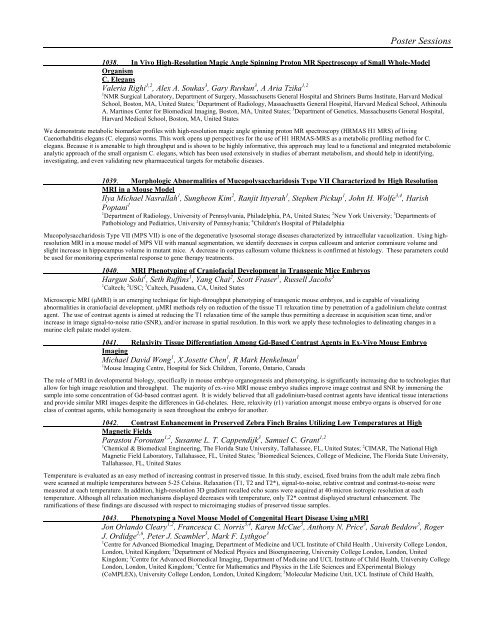TRADITIONAL POSTER - ismrm
TRADITIONAL POSTER - ismrm
TRADITIONAL POSTER - ismrm
Create successful ePaper yourself
Turn your PDF publications into a flip-book with our unique Google optimized e-Paper software.
Poster Sessions<br />
1038. In Vivo High-Resolution Magic Angle Spinning Proton MR Spectroscopy of Small Whole-Model<br />
Organism<br />
C. Elegans<br />
Valeria Righi 1,2 , Alex A. Soukas 3 , Gary Ruvkun 3 , A Aria Tzika 1,2<br />
1 NMR Surgical Laboratory, Department of Surgery, Massachusetts General Hospital and Shriners Burns Institute, Harvard Medical<br />
School, Boston, MA, United States; 2 Department of Radiology, Massachusetts General Hospital, Harvard Medical School, Athinoula<br />
A. Martinos Center for Biomedical Imaging, Boston, MA, United States; 3 Department of Genetics, Massachusetts General Hospital,<br />
Harvard Medical School, Boston, MA, United States<br />
We demonstrate metabolic biomarker profiles with high-resolution magic angle spinning proton MR spectroscopy (HRMAS H1 MRS) of living<br />
Caenorhabditis elegans (C. elegans) worms. This work opens up perspectives for the use of H1 HRMAS-MRS as a metabolic profiling method for C.<br />
elegans. Because it is amenable to high throughput and is shown to be highly informative, this approach may lead to a functional and integrated metabolomic<br />
analytic approach of the small organism C. elegans, which has been used extensively in studies of aberrant metabolism, and should help in identifying,<br />
investigating, and even validating new pharmaceutical targets for metabolic diseases.<br />
1039. Morphologic Abnormalities of Mucopolysaccharidosis Type VII Characterized by High Resolution<br />
MRI in a Mouse Model<br />
Ilya Michael Nasrallah 1 , Sungheon Kim 2 , Ranjit Ittyerah 1 , Stephen Pickup 1 , John H. Wolfe 3,4 , Harish<br />
Poptani 1<br />
1 Department of Radiology, University of Pennsylvania, Philadelphia, PA, United States; 2 New York University; 3 Departments of<br />
Pathobiology and Pediatrics, University of Pennsylvania; 4 Children's Hospital of Philadelphia<br />
Mucopolysaccharidosis Type VII (MPS VII) is one of the degenerative lysosomal storage diseases characterized by intracellular vacuolization. Using highresolution<br />
MRI in a mouse model of MPS VII with manual segmentation, we identify decreases in corpus callosum and anterior commisure volume and<br />
slight increase in hippocampus volume in mutant mice. A decrease in corpus callosum volume thickness is confirmed at histology. These parameters could<br />
be used for monitoring experimental response to gene therapy treatments.<br />
1040. MRI Phenotyping of Craniofacial Development in Transgenic Mice Embryos<br />
Hargun Sohi 1 , Seth Ruffins 1 , Yang Chai 2 , Scott Fraser 1 , Russell Jacobs 3<br />
1 Caltech; 2 USC; 3 Caltech, Pasadena, CA, United States<br />
Microscopic MRI (μMRI) is an emerging technique for high-throughput phenotyping of transgenic mouse embryos, and is capable of visualizing<br />
abnormalities in craniofacial development. μMRI methods rely on reduction of the tissue T1 relaxation time by penetration of a gadolinium chelate contrast<br />
agent. The use of contrast agents is aimed at reducing the T1 relaxation time of the sample thus permitting a decrease in acquisition scan time, and/or<br />
increase in image signal-to-noise ratio (SNR), and/or increase in spatial resolution. In this work we apply these technologies to delineating changes in a<br />
murine cleft palate model system.<br />
1041. Relaxivity Tissue Differentiation Among Gd-Based Contrast Agents in Ex-Vivo Mouse Embryo<br />
Imaging<br />
Michael David Wong 1 , X Josette Chen 1 , R Mark Henkelman 1<br />
1 Mouse Imaging Centre, Hospital for Sick Children, Toronto, Ontario, Canada<br />
The role of MRI in developmental biology, specifically in mouse embryo organogenesis and phenotyping, is significantly increasing due to technologies that<br />
allow for high image resolution and throughput. The majority of ex-vivo MRI mouse embryo studies improve image contrast and SNR by immersing the<br />
sample into some concentration of Gd-based contrast agent. It is widely believed that all gadolinium-based contrast agents have identical tissue interactions<br />
and provide similar MRI images despite the differences in Gd-chelates. Here, relaxivity (r1) variation amongst mouse embryo organs is observed for one<br />
class of contrast agents, while homogeneity is seen throughout the embryo for another.<br />
1042. Contrast Enhancement in Preserved Zebra Finch Brains Utilizing Low Temperatures at High<br />
Magnetic Fields<br />
Parastou Foroutan 1,2 , Susanne L. T. Cappendijk 3 , Samuel C. Grant 1,2<br />
1 Chemical & Biomedical Engineering, The Florida State University, Tallahassee, FL, United States; 2 CIMAR, The National High<br />
Magnetic Field Laboratory, Tallahassee, FL, United States; 3 Biomedical Sciences, College of Medicine, The Florida State University,<br />
Tallahassee, FL, United States<br />
Temperature is evaluated as an easy method of increasing contrast in preserved tissue. In this study, excised, fixed brains from the adult male zebra finch<br />
were scanned at multiple temperatures between 5-25 Celsius. Relaxation (T1, T2 and T2*), signal-to-noise, relative contrast and contrast-to-noise were<br />
measured at each temperature. In addition, high-resolution 3D gradient recalled echo scans were acquired at 40-micron isotropic resolution at each<br />
temperature. Although all relaxation mechanisms displayed decreases with temperature, only T2* contrast displayed structural enhancement. The<br />
ramifications of these findings are discussed with respect to microimaging studies of preserved tissue samples.<br />
1043. Phenotyping a Novel Mouse Model of Congenital Heart Disease Using μMRI<br />
Jon Orlando Cleary 1,2 , Francesca C. Norris 3,4 , Karen McCue 5 , Anthony N. Price 3 , Sarah Beddow 5 , Roger<br />
J. Ordidge 2,6 , Peter J. Scambler 5 , Mark F. Lythgoe 3<br />
1 Centre for Advanced Biomedical Imaging, Department of Medicine and UCL Institute of Child Health , University College London,<br />
London, United Kingdom; 2 Department of Medical Physics and Bioengineering, University College London, London, United<br />
Kingdom; 3 Centre for Advanced Biomedical Imaging, Department of Medicine and UCL Institute of Child Health, University College<br />
London, London, United Kingdom; 4 Centre for Mathematics and Physics in the Life Sciences and EXperimental Biology<br />
(CoMPLEX), University College London, London, United Kingdom; 5 Molecular Medicine Unit, UCL Institute of Child Health,















